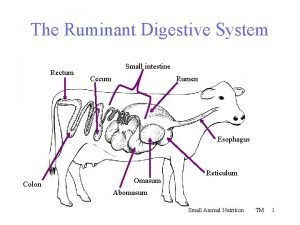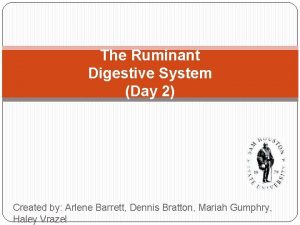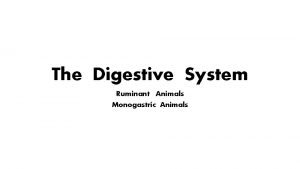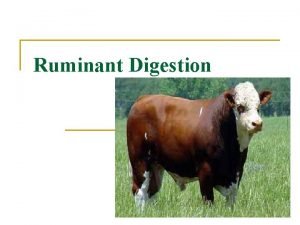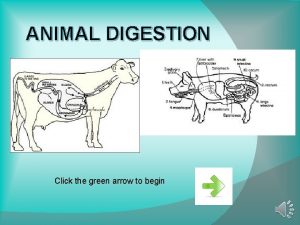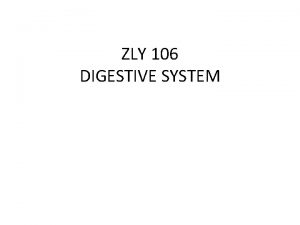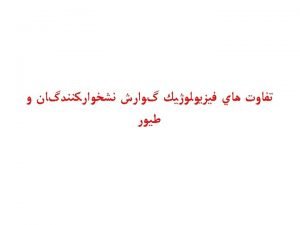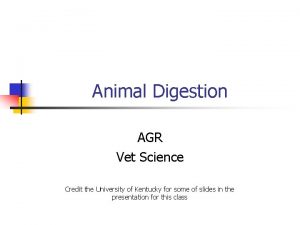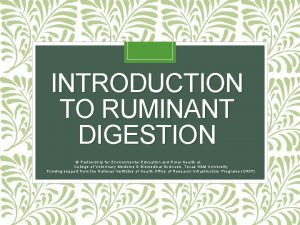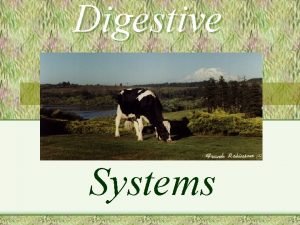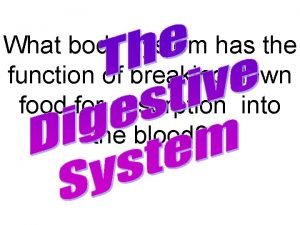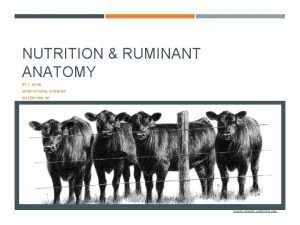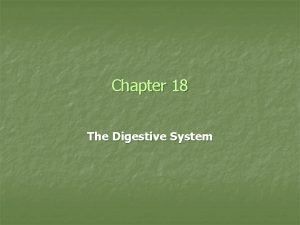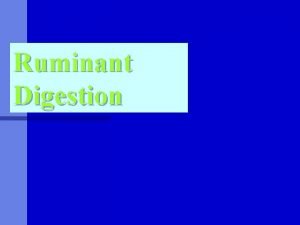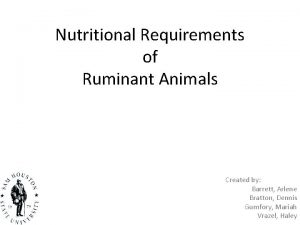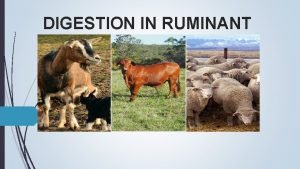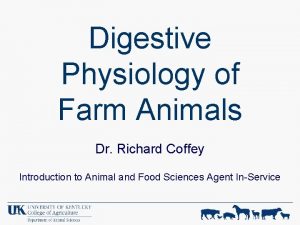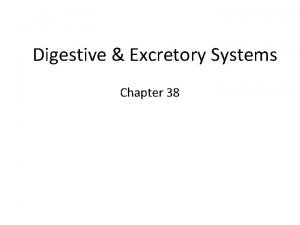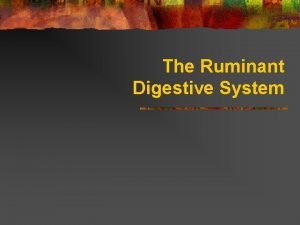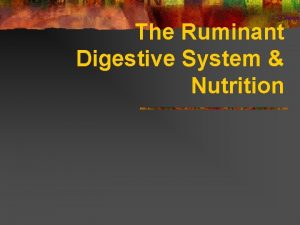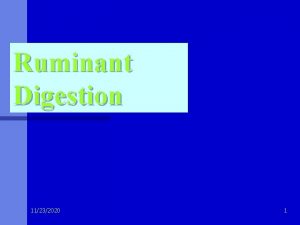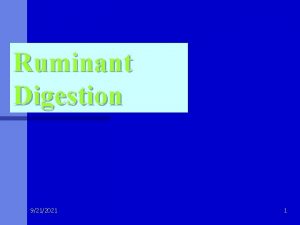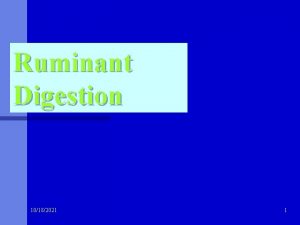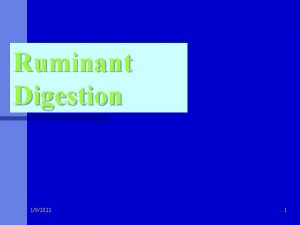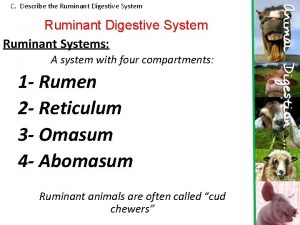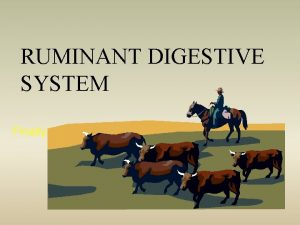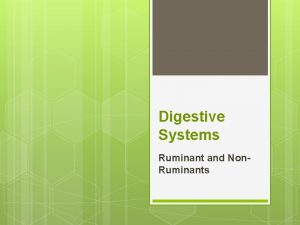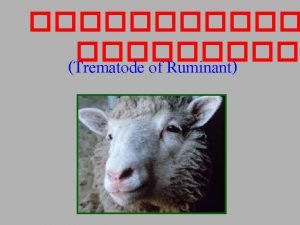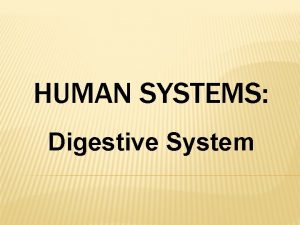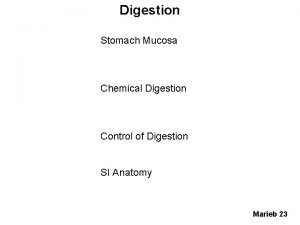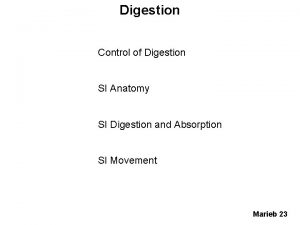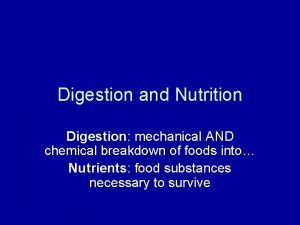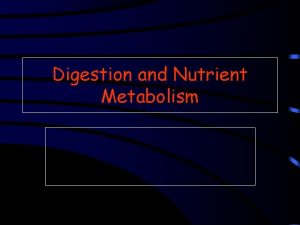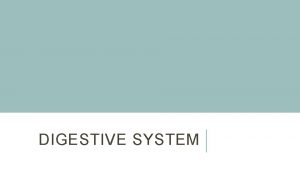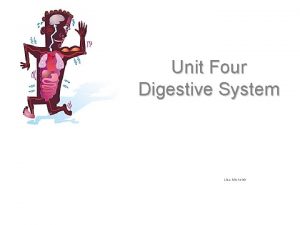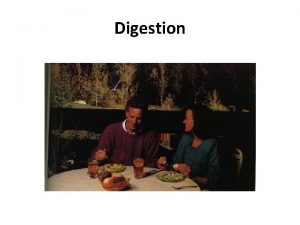Ruminant Digestion Different Digestive Systems n The three





































- Slides: 37

Ruminant Digestion

Different Digestive Systems n The three different types of digestive systems are: n Monogastric n Modified Monogastric n Ruminant

Ruminant n n A few animals with ruminant digestive systems are sheep, cattle, goats, deer and giraffes. Ruminant animals have four complex stomach structures. The four stomachs are called the rumen, reticulum, omasum and abomasum. Herbivores are usually ruminant animals.

Parts of Ruminant System n n n n Mouth- teeth and lips hold food and chew it, saliva moistens food. Esophagus-food travels to stomach. Four Compartments: 1 st-Rumen 2 nd-Reticulum 3 rd-Omasum 4 th-Abomasum

1 st Compartment: Rumen Large fermentation vat, where bacteria and protozoa thrive to break down roughages. n Rumen is lined with papillae to increase surface area and absorption n

Rumen n Contains microorganisms that digest cellulose and can synthesize amino acids as well as B-complex vitamins. Rumen Sizes in Cattle and Sheep Cow - 40 Gallons Sheep- 5 Gallons

2 nd Compartment- Reticulum n Reticulum has a lining with small compartments similar to a honeycomb. Hence its nickname the “honeycomb. ” n Interacts with the rumen in initiating mixing activity and provides additional storage for fermentation. n Capacity: n Cow: 2 Gallons n Sheep: 2 Quarts

3 rd Compartment: Omasum n n n Omasum has many folds, often referred to as manyplies. Aids in the grinding action of the food Capacity: Cow: 4 gallons Sheep: 1 quart

4 th Compartment: Abomasum n Abomasum: The true stomach n Corresponds with the stomach of monogastric animals. n Majority of Digestion takes place. n Capacity: n Cow 4 Gallons, Sheep 3 quarts

Small Intestine n Functions in splitting food molecules and in nutrient absorption. n Capacity of Ruminant Animals: n Cow: 15 Gallons or 130 feet n Sheep: 2 Gallons or 80 feet

Large Intestine n Functions in absorbing water and forms indigestible wastes into solids. n Last chance for minor nutrient absorption. n Capacity of Ruminant Animals n Cow: 10 gallons n Sheep: 6 quarts

Review of Ruminant Digestive Systems Animals that have ruminant digestive systems eat forage rapidly and later regurgitate the feed, known as the cud. n The regurgitated food is chewed thoroughly, swallowed and then more feed is regurgitated. This process is continued until all the feed is masticated. n

How the Ruminant System Works n Once the feed has arrived in the rumen, it is mixed with microorganisms, such as bacteria, protozoa and certain fungi. They assist the ruminant animal in utilizing cellulose, and in synthesizing protein from non-protein nitrogen and certain vitamins.

How the Ruminant System Works n Then the feed arrives in the Reticulum that is commonly referred to as the “honeycomb”. Its major function is to work with the rumen in mixing and grinding the feed. n Also functions in screening foreign objects from the digestive system.

How the Ruminant System Works n Then the feed arrives in the omasum, or the third compartment referred to as “manyplies. ” The omasum assists in removing 60 to 70 percent of the water before the feed enters the abomasum.

How the Ruminant System Works n Once the feed has arrived in the abomasum, or the “true stomach, ” digestive juices, which contain enzymes, break down proteins, and add moisture to the feed as it enters the small intestine.

Small & Large Intestine in Review n From the abomasum, the feed enters the small intestine where nutrients are absorbed in the blood system. n From the small intestine, the food passes into the large intestine where the water is removed and the feed is prepared for excretion.

Ruminant Digestive System Student Note Outline

Different Digestive Systems n 1… 2… 3… The three different types of digestive systems are:

Ruminant n n n n Ruminant animals have _____complex stomach structures. A few animals with ruminant digestive systems are_______, goats, _______ and giraffes. The four stomachs are called the_________, ________ and the _______are usually ruminant animals.

Parts of Ruminant System n n n n Mouth-teeth and lips hold food and chew it, saliva moistens food. Esophagus-________stomach. Four Compartments: 1 st 2 nd 3 rd 4 th-

1 st Compartment: Rumen Large fermentation vat, where ______and ______ thrive to break down roughages. n Rumen is lined with papillae to increase ______and absorption n

Rumen n Contains microorganisms that digest ______and can synthesize amino acids as well as B-complex vitamins. Rumen Sizes in Cattle & Sheep Cow-______ Sheep- ______

2 nd Compartment-Reticulum n Reticulum has a lining with small compartments similar to a honeycomb. Hence its nickname the “honeycomb. ” n Interacts with the rumen in initiating _______and provides additional storage for___________. n Capacity: n Cow: ______ n Sheep: ______

3 rd Compartment: Omasum n n n Omasum has many folds, often referred to as______. Aids in the grinding action of the food Capacity: Cow: _____ Sheep: _____

4 th Compartment: Abomasum n _______: The true stomach n Corresponds with the stomach of ________animals. n Majority of digestion takes place. n Capacity: n Cow _______ Sheep_____

Small Intestine n Functions in splitting food molecules and in____________. n Capacity of Ruminant Animals: n Cow: 15 Gallons or_______ n Sheep: 2 Gallons or_______

Large Intestine n Functions in absorbing_______ and forms indigestible wastes into solids. n Last chance for minor nutrient absorption. n Capacity of Ruminant Animals n Cow: _________ n Sheep: _________

Review of Ruminant Digestive Systems Animal that have ruminant digestive systems eat forage rapidly and later regurgitate the feed, known as_______. n The regurgitated food is chewed thoroughly, swallowed, and then more feed is regurgitated. This process is continued until all the feed is masticated. n

How the Ruminant System Works n Once the food has arrived in the rumen, it is mixed with microorganisms such as______, protozoa and certain fungi. They assist the ruminant animal in utilizing____, and in synthesizing protein from non-protein nitrogen and certain_______.

How the Ruminant System Works n The feed arrives in the ______that is commonly referred to as the “honeycomb. ” Its major function is to work with the rumen in mixing and grinding the feed. n Also functions in screening foreign objects from the digestive system.

How the Ruminant System Works n The feed arrives in the omasum, or the third compartment referred to as “_______”. The omasum assists in removing 60 to 70 percent of the _______before the feed enters the abomasum.

How the Ruminant System Works n Once the feed has arrived in the abomasum, or the “true stomach, ” _______, which contain enzymes break down_______, and add moisture to the feed as it enters the small intestine.

Small & Large Intestine in Review n From the abomasum, the feed enters the ______where nutrients are absorbed in the blood system. n From the small intestine, the food passes into the large intestine where the water is removed and the feed is prepared for excretion.



 Ruminant digestion
Ruminant digestion Define ruminant digestive system
Define ruminant digestive system Animali monogastrici
Animali monogastrici What is this
What is this Pseudo ruminant examples
Pseudo ruminant examples Deer digestive system
Deer digestive system Pprotozoa
Pprotozoa Digestive system in poultry
Digestive system in poultry Conclusion of digestive system
Conclusion of digestive system Ruminant
Ruminant Ruminant animals
Ruminant animals Saltine cracker digestion lab
Saltine cracker digestion lab Macrominerals
Macrominerals Caillette jeune ruminant
Caillette jeune ruminant Pancreatic juice
Pancreatic juice Ruminant animals
Ruminant animals Nutritional requirements for ruminant animals
Nutritional requirements for ruminant animals Ruminant animals
Ruminant animals Ruminant stomach parts
Ruminant stomach parts Section 38-3 the excretory system
Section 38-3 the excretory system Why do different polymers have different properties?
Why do different polymers have different properties? Technicolor test
Technicolor test Sound will travel at different speeds in different mediums.
Sound will travel at different speeds in different mediums. Library.thinkquest.org 19537
Library.thinkquest.org 19537 What is cultural relativism
What is cultural relativism Different angle different story
Different angle different story Acid base song
Acid base song Manufactured boards examples
Manufactured boards examples What things make us special
What things make us special Argumenterande tal struktur
Argumenterande tal struktur Hát kết hợp bộ gõ cơ thể
Hát kết hợp bộ gõ cơ thể Slidetodoc
Slidetodoc Bổ thể
Bổ thể Tỉ lệ cơ thể trẻ em
Tỉ lệ cơ thể trẻ em Chó sói
Chó sói Chụp phim tư thế worms-breton
Chụp phim tư thế worms-breton Hát lên người ơi alleluia
Hát lên người ơi alleluia Các môn thể thao bắt đầu bằng tiếng bóng
Các môn thể thao bắt đầu bằng tiếng bóng
